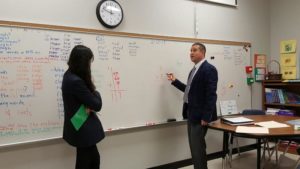 By Frank Zaremba, first published by Real Clear Education, February 15, 2017
By Frank Zaremba, first published by Real Clear Education, February 15, 2017
When I became a multi-classroom leader for the exceptional children’s (EC’s) team, I expected to be able to use my 15 years of experience as an EC teacher and dean of students to coach teachers, especially special education teachers, and help them grow.
But I quickly discovered that the people who needed support the most were the general classroom teachers who needed to know how to work with students with disabilities when an EC teacher couldn’t be in the room at the same time.
What was the key to getting everyone on the same page and making terrific progress? Scheduling.
With the implementation of “inclusive practices”—in which a general education and special education teacher instruct students with and without disabilities together in a general education classroom—teachers must collaborate more than ever. Scheduling can help or hinder that collaboration, with big implications for student learning.
The challenge begins early. General education teachers receive little training on teaching and accommodating students with disabilities beyond an “introduction to special education” course. So they were often at a loss for what to do with EC students. They might be given a copy of students’ individual education plans (IEPs) to absorb at a glance, then left to instruct the students with very minimal support. Special education teachers could only provide resource (pull-out) services based on IEP goals in a separate classroom during parts of the school day. I and the other multi-classroom leaders and our administrators, who formed a school-wide leadership team, knew something had to change.
Our biggest shift: We created block scheduling in which teachers specialized by subject, much like you would see in middle or high school, except we were doing it at the elementary level. That allowed teachers to focus on math, literacy or science/social studies and be able to really master their subject content. Students were flexibly grouped starting in first grade, moving to different classrooms throughout the day.
Clustering the students with disabilities in a few classrooms (together, but working with other students in the room, too) allowed us to create a cohesive schedule to support the learning process, making it easier for the special education teachers to work with groups of EC students in the general education setting.
In years past, the EC students were spread throughout the grade level, forcing the EC teacher to either move from classroom to classroom or pull all of the EC students into one general education classroom for co-taught lessons. In contrast, the new block schedule created flexibility for the EC teachers to go into the classrooms on a regular basis to support inclusive practices, team teach with the general education teacher during a mini lesson and work in small groups. Additionally, since all of the EC students were in the same class, there was less movement and disruption to their schedule.
This created opportunities for me to coach others throughout daily instruction. The EC teacher and I could now be in teachers’ classrooms daily, providing instant coaching and feedback that was as valuable as any professional development on inclusive practices that general education teachers would receive outside of the classroom. With this model came an EC assistant, who could support the students in the classroom when the EC teacher or I couldn’t be in there.
Now that the EC teachers had time scheduled to support instruction in the classroom, our next scheduling hurdle was finding time to plan with the general education teachers. When a school adopts Opportunity Culture® models such as multi-classroom leadership, one of the things the “school design team” focuses on is common planning and collaboration time for teaching teams. Our school built common planning time between general education and special education into the grade levels’ weekly planning schedule.
So, for example, on Mondays I meet with the fifth-grade literacy team for the week’s lesson planning. On Tuesday, I take those plans to a literacy planning meeting with the general education literacy co-teacher, so together we could create leveled literacy lessons for students with disabilities that were aligned with the grade’s lesson plans. I repeat that process for math on Wednesdays and Thursdays.
Our weekly meetings, planning and collaboration made us feel like a cohesive team, with immeasurable benefits to our confidence and teaching.
We saw measurable benefits too. EC students showed tremendous growth. Our fifth-grade EC students met state growth expectations in literacy and math, as our fourth-graders did in math, and in literacy, our fourth-grade EC students exceeded state growth expectations in literacy.
Even now, as our allotment for EC teachers has been cut from two full-time EC teachers to one full-time and one part-time, I still see the strategies in place for working with students with disabilities in the general education setting. The general education teachers continue to design and differentiate instruction to meet the various learning needs and styles with less support in their classrooms.
Scheduling isn’t exciting. And it might not seem like it would be the linchpin for success, but, to truly work together and provide the best possible instruction for students, we found that we had to begin with scheduling. While we continue to tweak our plan each year, the one constant is how we address the needs of our students with disabilities—a whole-school approach that we are committed to.
Frank Zaremba is in his third year as a multi-classroom leader at Barnette Elementary School in Huntersville, N.C. After moving from New York, he has worked for Charlotte-Mecklenburg Schools for 17 years as an exceptional children’s teacher, dean of students and MCL.
